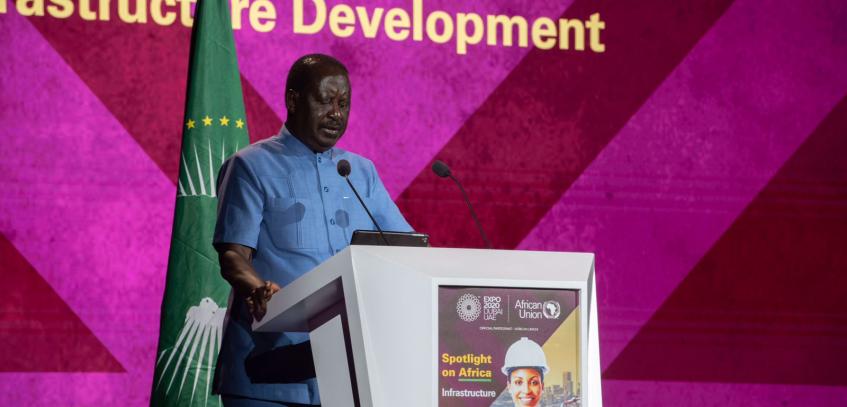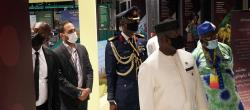AFRICA'S INFRASTRUCTURE GAP has remained wide over the years and, resulted in stifled socioeconomic growth and development.
Africa's industrialization has also been significantly diminished.
Africa's road network deficit is estimated at a minimum of 60,000 Km by 2040.
Africa's rail network deficit is at about 30,000 Km by 2040.
Airports and Ports need urgent development in a large number of countries and regions.
Perhaps of greatest significance is the energy infrastructure deficit, despite Africa's tremendous energy production and distribution potential.
Africa's current total installed capacity of 145 GW is only a fraction of the 700 GW which is the target by 2040.
Africa’s continental free trade area (AFCFTA) which aims to unite participating countries into a single trading market that would be the largest free trade zones in the world since the world trade organization was created in 1995. but trade liberalization policies alone will not be sufficient to drive intra-Africa trade. appropriate transport and energy infrastructure investment are a prerequisite to a profitable (AFCFTA) .
THE FINANCING GAP FOR AFRICA'S INFRASTRUCTURE is of great concern, given the central role of infrastructure in facilitating and enabling socioeconomic growth and development AND, regional trade.
The African Development Bank (AfDB) has estimated that the continent's infrastructure needs between US$ 130Bn-US$ 170Bn.
While these figures may appear large, they represent a small percentage of the financial resources that exist on the continent, in both the government and private sectors.
It worth noting, for example, that the African Pension Funds manage approximately US$ 350Bn of assets in Sub-Sahara Africa. Further, that many of these funds say that they struggle to find places to invest.
In Kenya, some 27 pension funds have formed a consortium to invest in infrastructure as a new asset class. Also important is the fact that governments and donor agencies are exploring ways to take some of the risk by issuing guarantees.
-PROGRAM FOR INFRASTRUCTURE DEVELOPMENT IN AFRICA(PIDA), PRIORITY ACTION PLAN (PAP) 1...(PIDA PAP1) secured some US$ 82Bn of infrastructure financing commitments throughout its implementation period between 2012-2020.
A significant number (30%) of the PIDA PAP 1 projects DID NOT surpass the Feasibility Stage.
Inability to secure the needed resources for adequate Project Preparation is of great concern and, requires innovative intervention. This is especially so with all the PAP projects which are regional in nature, and require national ownership AND, regional commitment.
Regional priority infrastructure projects MUST be incorporated in National Development Plans (NDPs) , and also be part of the RECs infrastructure Masterplans. This is the only way that the numerous missing links (rail and road! ) in Africa can be developed.
EACH COUNTRY MUST PLAY ITS ROLE FOR MEANINGFUL REGIONAL INTEGRATION AND TRADE TO BE REALIZED.
The Lamu Port, South Sudan, Ethiopia Transport Corridor (LAPSSET) is an example of a regional project whose implementation has been delayed due to the lack of national ownership by the various footprint countries, and also failure by RECs to prioritize this important transport and economic corridor. The current plans to develop a regional transboundary project coordination/management mechanism will go a long way in the implementation of this critical corridor.
FINANCING FOR PROJECT PREPARATION must be prioritized if the 70 PIDA PAP 2 projects (2021-2030) are to be realized. The lack of a strong pipeline of well-prepared, bankable infrastructure projects has been identified as one of the key constraints to financing for Africa's infrastructure. A more creative and sustainable solution has to be found.
It is against this backdrop that my office has been exploring the idea of a special African fund/facility to compliment other efforts such as the NEPAD Infrastructure Project Preparation Facility (NEPAD-IPPF) that is hosted by the AfDB,as well as the Service Delivery Mechanism (SDM) within AUDA-NEPAD.
I am especially keen to work with the private sector and institutional investors from around the continent (and outside the continent) to enhance private sector participation throughout the project cycle of the 70 prioritized regional projects that are included in the PAP 2(2021-2030).
My office is encouraging strategic partnerships and coordination among key public and private sector stakeholders, as well as the various development partners who can play critical roles in the development of de-risking mechanisms and facilities.
In conclusion, I wish to again reiterate the philosophical premise that effective project preparation and coordination is key to alleviating the African infrastructure








